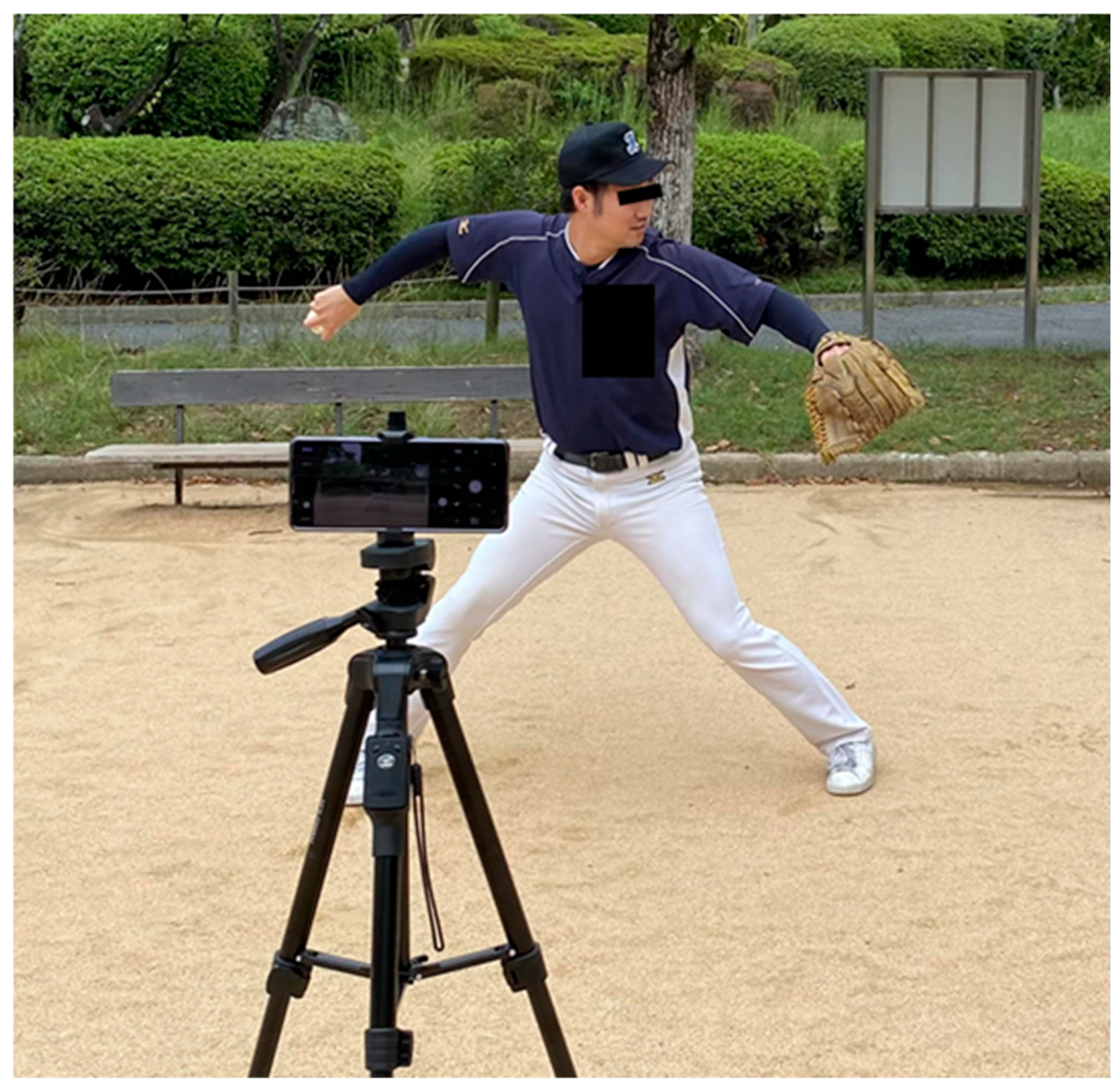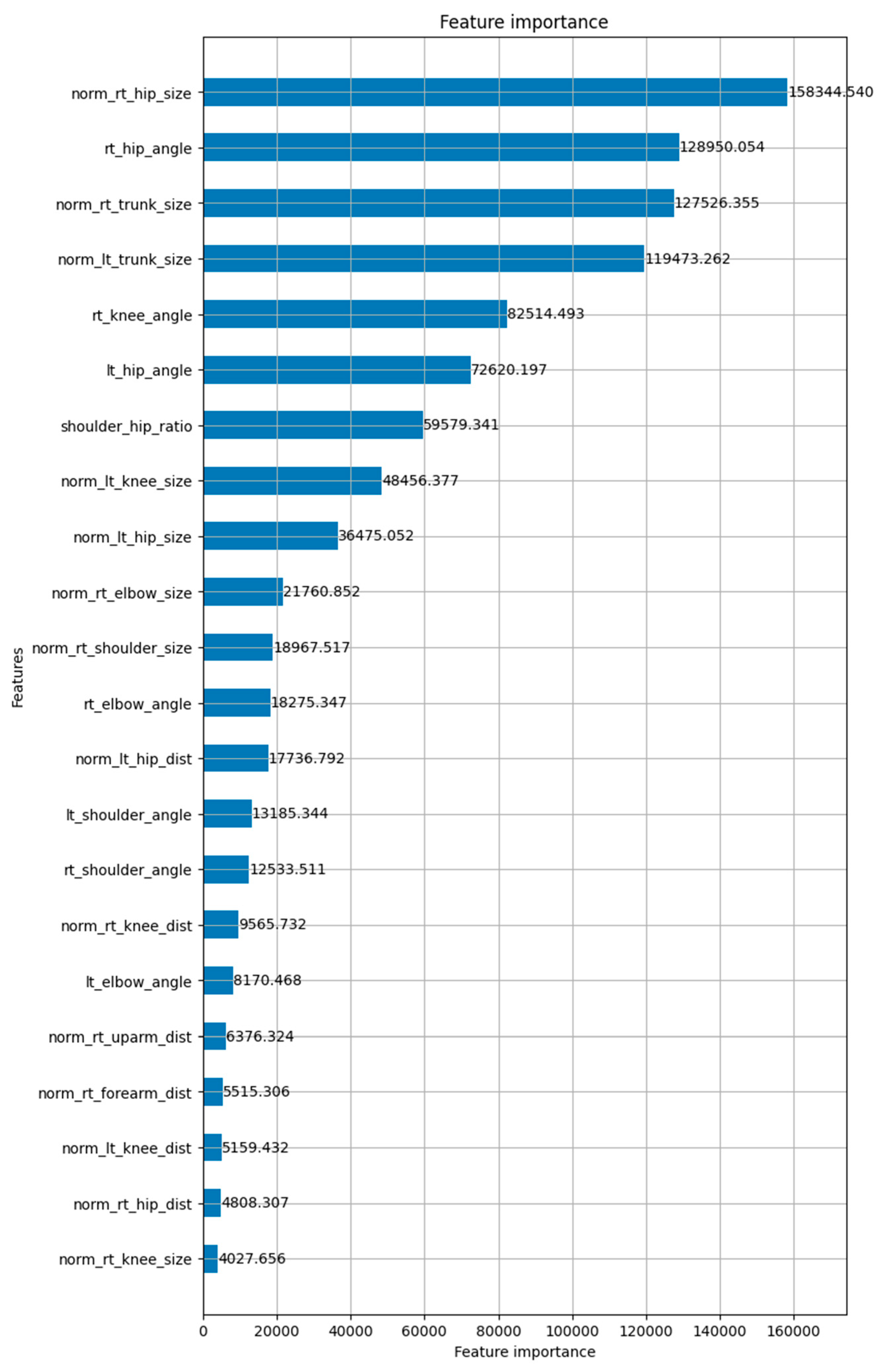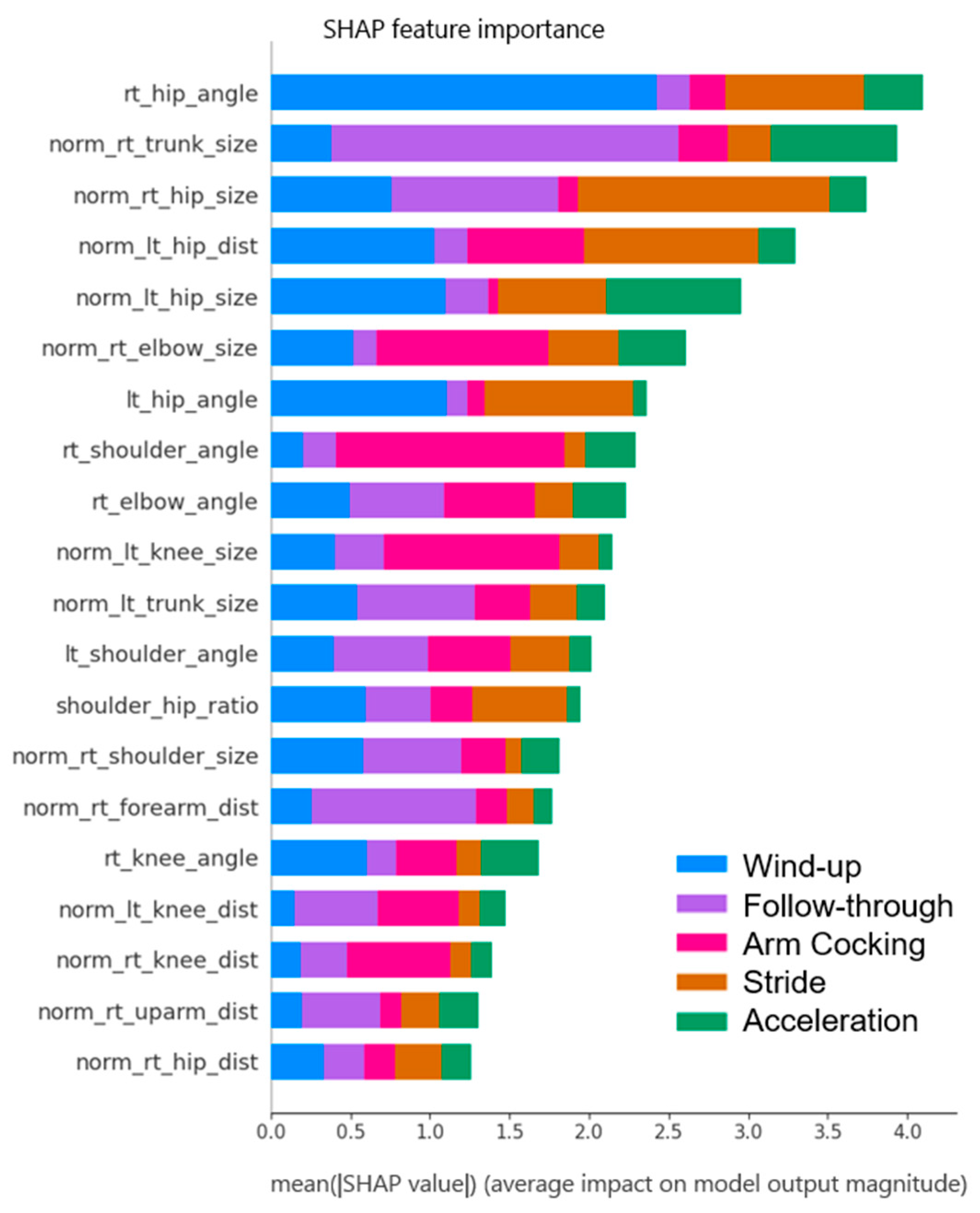Automated Classification of Baseball Pitching Phases Using Machine Learning and Artificial Intelligence-Based Posture Estimation
Abstract
1. Introduction
2. Materials and Methods
2.1. Participants
2.2. Data Acquisition and Image Processing by Media Pipe
2.3. Parameters
2.4. Machine Learning (ML)
2.5. Pitching Phase Definitions
2.6. Evaluation
3. Results
4. Discussion
5. Conclusions
Author Contributions
Funding
Institutional Review Board Statement
Informed Consent Statement
Data Availability Statement
Acknowledgments
Conflicts of Interest
Abbreviations
| AI | Artificial Intelligence |
| ML | Machine Learning |
| RF | Random Forest |
| LightGBM | Light Gradient Boosting Machine |
| MLS | Maximum Lift of Stride Leg |
| SFC | Stride Foot Contact |
| MER | Maximum External Rotation |
| BR | Ball Release |
| SHAP | Shapley Additive Explanations |
References
- Diffendaffer, A.Z.; Bagwell, M.S.; Fleisig, G.S.; Yanagita, Y.; Stewart, M.; Cain, E.L., Jr.; Dugas, J.R.; Wilk, K.E. The Clinician’s Guide to Baseball Pitching Biomechanics. Sports Health 2023, 15, 274–281. [Google Scholar] [CrossRef] [PubMed]
- Calabrese, G.J. Pitching mechanics, revisited. Int. J. Sports Phys. Ther. 2013, 8, 652–660. [Google Scholar] [PubMed]
- Conte, S.A.; Fleisig, G.S.; Dines, J.S.; Wilk, K.E.; Aune, K.T.; Patterson-Flynn, N.; ElAttrache, N. Prevalence of Ulnar Collateral Ligament Surgery in Professional Baseball Players. Am. J. Sports Med. 2015, 43, 1764–1769. [Google Scholar] [CrossRef] [PubMed]
- Fleisig, G.S.; Andrews, J.R.; Cutter, G.R.; Weber, A.; Loftice, J.; McMichael, C.; Hassell, N.; Lyman, S. Risk of serious injury for young baseball pitchers: A 10-year prospective study. Am. J. Sports Med. 2011, 39, 253–257. [Google Scholar] [CrossRef]
- Reinold, M.M.; Macrina, L.C.; Fleisig, G.S.; Aune, K.; Andrews, J.R. Effect of a 6-Week Weighted Baseball Throwing Program on Pitch Velocity, Pitching Arm Biomechanics, Passive Range of Motion, and Injury Rates. Sports Health 2018, 10, 327–333. [Google Scholar] [CrossRef]
- Cohen, A.D.; Garibay, E.J.; Solomito, M.J. The Association Among Trunk Rotation, Ball Velocity, and the Elbow Varus Moment in Collegiate-Level Baseball Pitchers. Am. J. Sports Med. 2019, 47, 2816–2820. [Google Scholar] [CrossRef]
- Solomito, M.J.; Garibay, E.J.; Nissen, C.W. A Biomechanical Analysis of the Association Between Forearm Mechanics and the Elbow Varus Moment in Collegiate Baseball Pitchers. Am. J. Sports Med. 2018, 46, 52–57. [Google Scholar] [CrossRef]
- Takagi, Y.; Oi, T.; Tanaka, H.; Inui, H.; Fujioka, H.; Tanaka, J.; Yoshiya, S.; Nobuhara, K. Increased horizontal shoulder abduction is associated with an increase in shoulder joint load in baseball pitching. J. Shoulder Elbow Surg. 2014, 23, 1757–1762. [Google Scholar] [CrossRef]
- Nakano, N.; Sakura, T.; Ueda, K.; Omura, L.; Kimura, A.; Iino, Y.; Fukashiro, S.; Yoshioka, S. Evaluation of 3D Markerless Motion Capture Accuracy Using OpenPose With Multiple Video Cameras. Front. Sports Act. Living 2020, 2, 50. [Google Scholar] [CrossRef]
- Dobos, T.J.; Bench, R.W.G.; McKinnon, C.D.; Brady, A.; Boddy, K.J.; Holmes, M.W.R.; Sonne, M.W.L. Validation of pitchAI(TM) markerless motion capture using marker-based 3D motion capture. Sports Biomech. 2025, 24, 587–607. [Google Scholar] [CrossRef]
- Takigami, S.; Inui, A.; Mifune, Y.; Nishimoto, H.; Yamaura, K.; Kato, T.; Furukawa, T.; Tanaka, S.; Kusunose, M.; Ehara, Y.; et al. Estimation of Shoulder Joint Rotation Angle Using Tablet Device and Pose Estimation Artificial Intelligence Model. Sensors 2024, 24, 2912. [Google Scholar] [CrossRef]
- Kusunose, M.; Inui, A.; Nishimoto, H.; Mifune, Y.; Yoshikawa, T.; Shinohara, I.; Furukawa, T.; Kato, T.; Tanaka, S.; Kuroda, R. Measurement of Shoulder Abduction Angle with Posture Estimation Artificial Intelligence Model. Sensors 2023, 23, 6445. [Google Scholar] [CrossRef]
- Zaremski, J.L.; Zeppieri, G.; Tripp, B.L. Injury Prevention Considerations in Adolescent Overhead-Throwing Athletes. Curr. Phys. Med. Rehabil. Rep. 2019, 7, 216–226. [Google Scholar] [CrossRef]
- Aguinaldo, A.L.; Buttermore, J.; Chambers, H. Effects of upper trunk rotation on shoulder joint torque among baseball pitchers of various levels. J. Appl. Biomech. 2007, 23, 42–51. [Google Scholar] [CrossRef] [PubMed]
- Dillman, C.J.; Fleisig, G.S.; Andrews, J.R. Biomechanics of pitching with emphasis upon shoulder kinematics. J. Orthop. Sports Phys. Ther. 1993, 18, 402–408. [Google Scholar] [CrossRef]
- Fleisig, G.; Chu, Y.; Weber, A.; Andrews, J. Variability in baseball pitching biomechanics among various levels of competition. Sports Biomech. 2009, 8, 10–21. [Google Scholar] [CrossRef]
- Werner, S.L.; Fleisig, G.S.; Dillman, C.J.; Andrews, J.R. Biomechanics of the elbow during baseball pitching. J. Orthop. Sports Phys. Ther. 1993, 17, 274–278. [Google Scholar] [CrossRef]
- Bewick, V.; Cheek, L.; Ball, J. Statistics review 14: Logistic regression. Crit. Care 2005, 9, 112–118. [Google Scholar] [CrossRef] [PubMed]
- Srivilaithon, W.; Thanasarnpaiboon, P. Performance of machine learning models in predicting difficult laryngoscopy in the emergency department: A single-centre retrospective study comparing with conventional regression method. BMC Emerg. Med. 2025, 25, 28. [Google Scholar] [CrossRef] [PubMed]
- Yan, J.; Xu, Y.; Cheng, Q.; Jiang, S.; Wang, Q.; Xiao, Y.; Ma, C.; Yan, J.; Wang, X. LightGBM: Accelerated genomically designed crop breeding through ensemble learning. Genome Biol. 2021, 22, 271. [Google Scholar] [CrossRef]
- Fleisig, G.S.; Andrews, J.R.; Dillman, C.J.; Escamilla, R.F. Kinetics of baseball pitching with implications about injury mechanisms. Am. J. Sports Med. 1995, 23, 233–239. [Google Scholar] [CrossRef]
- Fleisig, G.S.; Barrentine, S.W.; Escamilla, R.F.; Andrews, J.R. Biomechanics of overhand throwing with implications for injuries. Sports Med. 1996, 21, 421–437. [Google Scholar] [CrossRef]
- Doyen, S.; Taylor, H.; Nicholas, P.; Crawford, L.; Young, I.; Sughrue, M.E. Hollow-tree super: A directional and scalable approach for feature importance in boosted tree models. PLoS ONE 2021, 16, e0258658. [Google Scholar] [CrossRef] [PubMed]
- Tseng, P.Y.; Chen, Y.T.; Wang, C.H.; Chiu, K.M.; Peng, Y.S.; Hsu, S.P.; Chen, K.L.; Yang, C.Y.; Lee, O.K. Prediction of the development of acute kidney injury following cardiac surgery by machine learning. Crit. Care 2020, 24, 478. [Google Scholar] [CrossRef] [PubMed]
- Lyman, S.; Fleisig, G.S.; Andrews, J.R.; Osinski, E.D. Effect of pitch type, pitch count, and pitching mechanics on risk of elbow and shoulder pain in youth baseball pitchers. Am. J. Sports Med. 2002, 30, 463–468. [Google Scholar] [CrossRef]
- Aguinaldo, A.L.; Chambers, H. Correlation of throwing mechanics with elbow valgus load in adult baseball pitchers. Am. J. Sports Med. 2009, 37, 2043–2048. [Google Scholar] [CrossRef]
- Douoguih, W.A.; Dolce, D.L.; Lincoln, A.E. Early Cocking Phase Mechanics and Upper Extremity Surgery Risk in Starting Professional Baseball Pitchers. Orthop. J. Sports Med. 2015, 3, 2325967115581594. [Google Scholar] [CrossRef] [PubMed]
- Chalmers, P.N.; Wimmer, M.A.; Verma, N.N.; Cole, B.J.; Romeo, A.A.; Cvetanovich, G.L.; Pearl, M.L. The Relationship Between Pitching Mechanics and Injury: A Review of Current Concepts. Sports Health 2017, 9, 216–221. [Google Scholar] [CrossRef]
- Dompier, T.P.; Marshall, S.W.; Kerr, Z.Y.; Hayden, R. The National Athletic Treatment, Injury and Outcomes Network (NATION): Methods of the Surveillance Program, 2011–2012 Through 2013–2014. J. Athl. Train. 2015, 50, 862–869. [Google Scholar] [CrossRef]
- Yard, E.E.; Collins, C.L.; Comstock, R.D. A comparison of high school sports injury surveillance data reporting by certified athletic trainers and coaches. J. Athl. Train. 2009, 44, 645–652. [Google Scholar] [CrossRef]







| Parameter | Definition |
|---|---|
| norm_rt_forearm_dist | Distance between the right elbow and right wrist joints, normalized by rt_trunk_dist. |
| norm_rt_uparm_dist | Distance between the right shoulder and right elbow joints, normalized by rt_trunk_dist. |
| norm_rt_hip_dist | Distance between the right shoulder and right hip joints, normalized by rt_trunk_dist. |
| norm_rt_knee_dist | Distance between the right hip and right knee joints, normalized by rt_trunk_dist. |
| norm_lt_hip_dist | Distance between the left shoulder and left hip joints, normalized by rt_trunk_dist. |
| norm_lt_knee_dist | Distance between the left hip and left knee joints, normalized by rt_trunk_dist. |
| rt_elbow_angle | Angle formed by the right shoulder, right elbow, and right wrist joints. |
| rt_shoulder_angle | Angle formed by the right elbow, right shoulder, and right hip joints. |
| lt_elbow_angle | Angle formed by the left shoulder, left elbow, and left wrist joints. |
| lt_shoulder_angle | Angle formed by the left elbow, left shoulder, and left hip joints. |
| rt_hip_angle | Angle formed by the right shoulder, right hip, and right knee joints. |
| rt_knee_angle | Angle formed by the right hip, right knee, and right ankle joints. |
| lt_hip_angle | Angle formed by the left shoulder, left hip, and left knee joints. |
| lt_knee_angle | Angle formed by the left hip, left knee, and left ankle joints. |
| shoulder_hip_ratio | Ratio of the distance between the left and right shoulder joints to the distance between the left and right hip joints. |
| norm_rt_elbow_size | Cross product of the vector from the right shoulder to the right elbow and the vector from the right elbow to the right wrist, normalized by the square of rt_trunk_dist. |
| norm_rt_shoulder_size | Cross product of the vector from the right shoulder to the right wrist and the vector from the right shoulder to the right hip, normalized by the square of rt_trunk_dist. |
| norm_rt_trunk_size | Cross product of the vector from the right shoulder to the left shoulder and the vector from the right shoulder to the right hip, normalized by the square of rt_trunk_dist. |
| norm_lt_trunk_size | Cross product of the vector from the right shoulder to the left shoulder and the vector from the right shoulder to the left hip, normalized by the square of rt_trunk_dist. |
| norm_rt_hip_size | Cross product of the vector from the right hip to the right knee and the vector from the right shoulder to the right hip, normalized by the square of rt_trunk_dist. |
| norm_rt_knee_size | Cross product of the vector from the right knee to the right ankle and the vector from the right hip to the right knee, normalized by the square of rt_trunk_dist. |
| norm_lt_hip_size | Cross product of the vector from the left hip to the left knee and the vector from the right shoulder to the left hip, normalized by the square of rt_trunk_dist. |
| norm_lt_knee_size | Cross product of the vector from the left knee to the left ankle and the vector from the left hip to the left knee, normalized by the square of rt_trunk_dist. |
| Accuracy | Recall | |||||
|---|---|---|---|---|---|---|
| Wind-Up | Stride | Cocking | Acceleration | Follow-Through | ||
| LightGBM | 0.9971 | 0.9978 | 0.9955 | 0.9478 | 0.8684 | 0.9813 |
| Random Forest | 0.9419 | 0.9601 | 0.7643 | 0.8495 | 0.8167 | 0.9815 |
| Logistic Regression | 0.9374 | 0.9361 | 0.8786 | 0.8572 | 0.8722 | 0.9754 |
Disclaimer/Publisher’s Note: The statements, opinions and data contained in all publications are solely those of the individual author(s) and contributor(s) and not of MDPI and/or the editor(s). MDPI and/or the editor(s) disclaim responsibility for any injury to people or property resulting from any ideas, methods, instructions or products referred to in the content. |
© 2025 by the authors. Licensee MDPI, Basel, Switzerland. This article is an open access article distributed under the terms and conditions of the Creative Commons Attribution (CC BY) license (https://creativecommons.org/licenses/by/4.0/).
Share and Cite
Osawa, S.; Inui, A.; Mifune, Y.; Yamaura, K.; Yoshikawa, T.; Shinohara, I.; Kusunose, M.; Tanaka, S.; Takigami, S.; Ehara, Y.; et al. Automated Classification of Baseball Pitching Phases Using Machine Learning and Artificial Intelligence-Based Posture Estimation. Appl. Sci. 2025, 15, 12155. https://doi.org/10.3390/app152212155
Osawa S, Inui A, Mifune Y, Yamaura K, Yoshikawa T, Shinohara I, Kusunose M, Tanaka S, Takigami S, Ehara Y, et al. Automated Classification of Baseball Pitching Phases Using Machine Learning and Artificial Intelligence-Based Posture Estimation. Applied Sciences. 2025; 15(22):12155. https://doi.org/10.3390/app152212155
Chicago/Turabian StyleOsawa, Shin, Atsuyuki Inui, Yutaka Mifune, Kohei Yamaura, Tomoya Yoshikawa, Issei Shinohara, Masaya Kusunose, Shuya Tanaka, Shunsaku Takigami, Yutaka Ehara, and et al. 2025. "Automated Classification of Baseball Pitching Phases Using Machine Learning and Artificial Intelligence-Based Posture Estimation" Applied Sciences 15, no. 22: 12155. https://doi.org/10.3390/app152212155
APA StyleOsawa, S., Inui, A., Mifune, Y., Yamaura, K., Yoshikawa, T., Shinohara, I., Kusunose, M., Tanaka, S., Takigami, S., Ehara, Y., Nakabayashi, D., Higashi, T., Wakamatsu, R., Hayashi, S., Matsumoto, T., & Kuroda, R. (2025). Automated Classification of Baseball Pitching Phases Using Machine Learning and Artificial Intelligence-Based Posture Estimation. Applied Sciences, 15(22), 12155. https://doi.org/10.3390/app152212155






